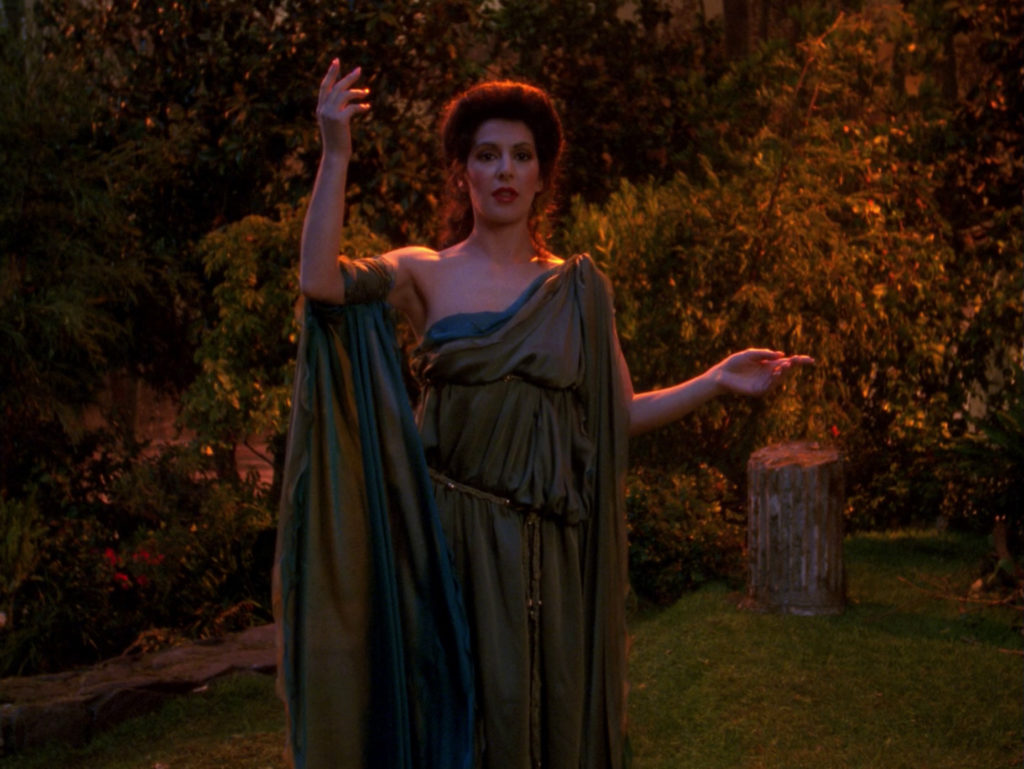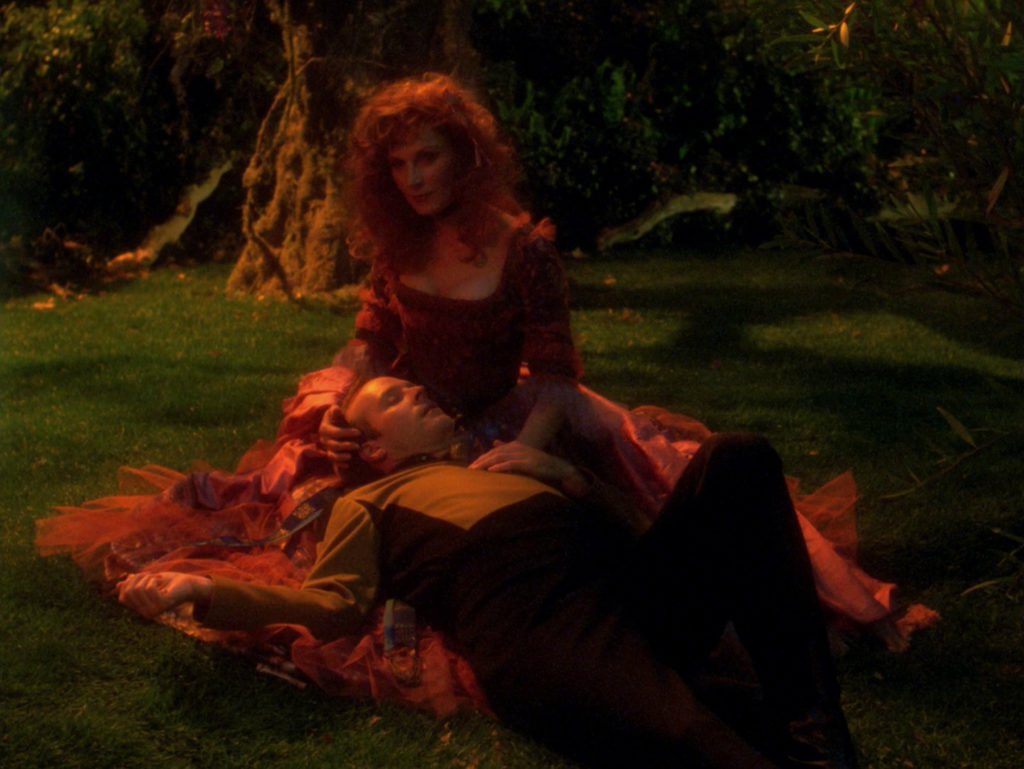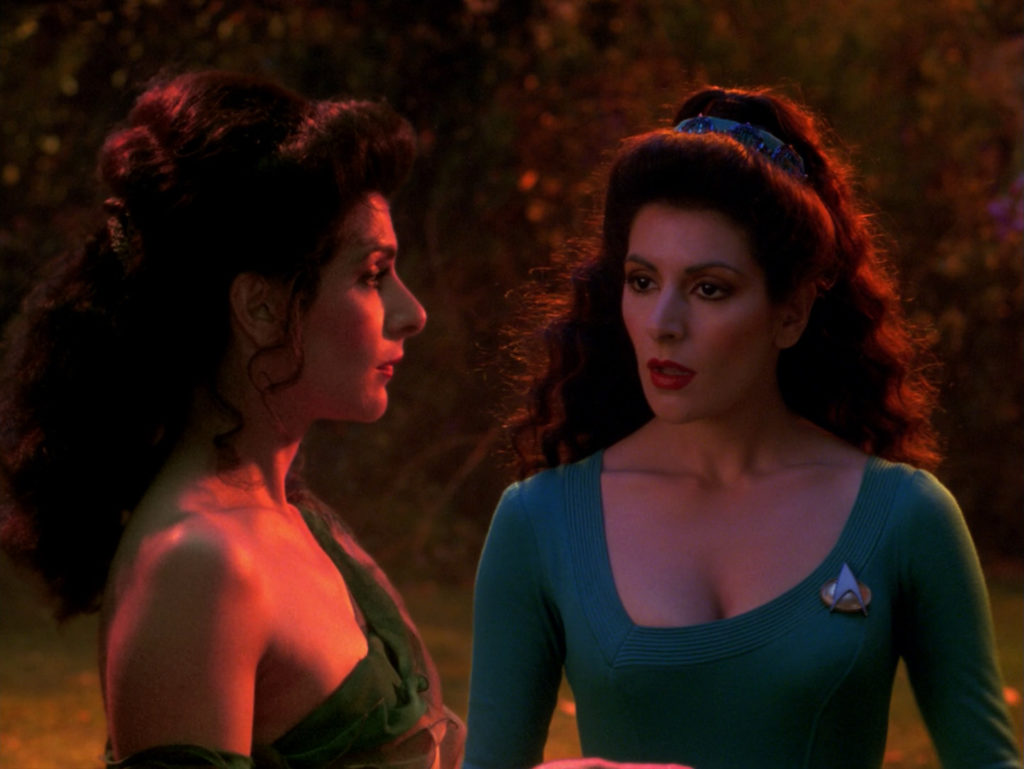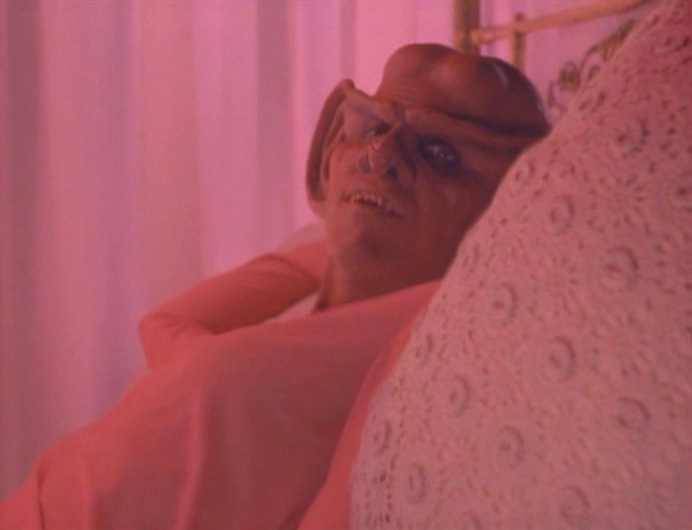 With virtual reality (VR) permeating global markets, I thought that my initial reaction of resentment was the beginning of being officially Old and Out of Touch. That’s when I realized that what I was seeing in our world parallels all the Star Trek episodes that used VR in the Holodeck to violate my favorite powerful women of the Alpha Quadrant.
With virtual reality (VR) permeating global markets, I thought that my initial reaction of resentment was the beginning of being officially Old and Out of Touch. That’s when I realized that what I was seeing in our world parallels all the Star Trek episodes that used VR in the Holodeck to violate my favorite powerful women of the Alpha Quadrant.
Often the Holodeck is used in Star Trek as a plot device to put female officers into sexualizing situations they wouldn’t consensually participate in. In The Next Generation’s “Hollow Pursuits” and Deep Space Nine’s “Meridian,” the power of female officers is undermined and their right to their bodies is degraded through the use of their likeness in the Holodeck.
Given that pornography is a driving force advancing VR technology, how are these ethical issues of consent and technology currently being addressed in our own society? In a world where a Toronto-based company named “Holodexxx” is already creating VR adult games, how long will it be before these scenarios are a reality for today’s women?

In “Hollow Pursuits,” we follow the bumbling Lieutenant Barclay into his personally designed Holodeck programs. Here, he is the sword-fighting “Master Barclay” who makes women swoon, rather than the nervous and chronically late “Broccoli”, as he is known to his crew mates. We find him napping on the lap of a dolled-up Dr. Crusher, joined by a toga-clad Counsellor Troi who declares herself “the Goddess of Empathy” and encourages all to “cast off your inhibitions and embrace love, truth, joy.”
This use of Troi and Crusher’s bodies without their knowledge or consent demonstrates rape culture, which is the result of societal attitudes that normalize sexual abuse and non-consensual interactions with others’ bodies. It is clear in this case that Troi and Crusher did not have the sexual agency to choose if their likenesses would engage sexually with Barclay whenever he should enter the Holodeck. This culture is enforced by the reactions of Barclay’s crewmates upon discovering his personal programs. Lieutenant Commander Geordi La Forge feels that “what you do in the holodeck is your own business” and that Barclay’s use of Troi demonstrates “quite a healthy fantasy life.” Commander Riker is initially outraged when seeing Barclay sword fighting the ship’s commanders, but becomes good natured and laughing when he discovers Troi’s sexualized image. This ‘boys will be boys’ attitude of finding the use of Troi and Crusher’s bodies comical minimizes the harm of these non-consensual interactions.
La Forge also argues that for Barclay “there’s a part of this that is oddly therapeutic.” On the one hand, VR holds as much potential for sexual education and therapy as it does for sexual objectification. As when we saw The Doctor and Seven of Nine in Voyager explore empathy and human interactions through Holodeck programs, VR could be a medium through which people could practice disclosing an STI to a partner, discussing their desires, or recognizing the signs of affirmative consent. For an example from today’s stardate, a series called “Virtual Sexology” run by BaDoinkVR has created a series of videos to help people overcome common sexual problems. A video geared towards men that demonstrates how some women need to be physically touched to become aroused before sex was the company’s most downloaded video, educational or otherwise, in 2016.
With the proper consents in place, VR could provide a safer environment for users to engage in any variety of sexual practices. With the ability to choose any virtual representation, users could have a body of any gender and appearance they want, exploring their tastes and expression in a way that could lessen gender dysphoria or body dysmorphia. They could engage in practices that are taboo or socially restricted without harm to themselves or others.
Undoubtedly, today VR pornography is a game changer. Like it has revolutionized the printing press and online payment systems, pornography will be the driving force behind VR technology, according to the New York Times’ Virtual Reality Gets Naughty. Currently, all the lifelike avatars available for VR programs are of porn performers who have been recorded from every angle to create VR representations of the sexual acts they have consented to. This brings to mind the lighthearted way that we watch Commander Riker cheekily instruct the computer to create his ideal partner for a date at the jazz club.

However, the creation of avatars without their knowledge or consent is a different matter entirely, and the pornography industry is notoriously difficult to regulate. The sector, and society as a whole, has not yet decided where our ethics lie regarding using someone’s likeness to have sex with them in virtual reality. Currently in the sex doll industry, one manufacturing company requires written consent from a model when creating a commissioned doll based on a real person. But can you do something to an avatar that they would not consent to in real life? How does revenge porn fit in? Will there be an option to “computer, end program” when one no longer consents to their VR avatar being used in this way?
In the Deep Space Nine episode “Meridian”, Quark’s business associate Tiron, who has enough money to own his own personal holosuite, requests a program featuring Major Kira Nerys. Quark attempts to create this program from a holoscan of Kira, as well as the data contained in her personnel files, gaining her image, voice, and psychiatric history. This use of her image is particularly egregious as Quark intends to profit off the program, but luckily, Kira remains a step ahead and is able to sabotage the program so Tiron finds a woman with Quark’s head in bed in the Holodeck).

In today’s vernacular, this type of program is a “deepfake,” a video generated by artificial intelligence which, in this context, consists of a particular person’s face attached to the body of a porn performer. For those who would prefer a personalized program of a specific woman over Quark’s suggestion of “a picnic with the pleasure goddess of Rixx,” the technology is becoming more and more accessible. Reddit user “Deepfakes” began posting such videos in 2017, and by 2018 had released a simple application called FakeApp which democratized the process of creating deepfakes. Suddenly, all the Tirons of the world needed were hundreds of photos of someone and the FakeApp algorithm to create their own customized video, allowing Reddit users to create full VR programs as easily as Quark could with a quick holoscan of Major Kira.
Media attention has largely glazed over the gendered implications of this technology to focus on the potential for ‘fake news’ to circulate. The classic example is of the ability to create a video of the President launching nuclear weapons. (For an innocuous, SFW example, see this video of Steve Buscemi as Jennifer Lawrence). As Samantha Cole writes for Broadly, “we must first acknowledge that the technology that could start a nuclear war was born as a way for men to have their full, fantastical way with women’s bodies.”
The rape culture implicit in Star Trek’s holodeck episodes not only made my skin crawl, but demeaned the characters’ leadership and authority by casting them in non-consensual, scandalous holodeck adventures. As a plot point, the writers put Troi and Crusher in situations they would not enter as the strong officers they are. These scenes upped their status as sex symbols to appeal to the male gaze while maintaining that they are equal crew members living in a post-patriarchal utopia. I find the TNG writing room as guilty as Barclay of casting Troi as a ‘goddess of empathy,’ rather than the valuable leader, diplomat, and crew member she is.
Sci-Fi can act as a tool to radicalize viewers’ subjectivity, and to push beyond our ‘cognitive frontier.’ Ironically, the holodeck (as the fiction within the fiction of the show), instead dampens and reinforces the status quo of rape culture and objectification in the workplace. In this way, the holodeck functions as a suspending of the utopian ideals of the federation when it comes to gender relations and misogyny.
These Star Trek episodes disturbed me because we now live in an era where this could happen to anyone. Not all of us have a shape-shifting security guard beside us to stop nosy bartenders from taking a nonconsensual holo-image or downloading public images of us. As we further explore the frontier of VR pornography, both amateur and professional producers can be held accountable to ethical production, and we can all help to ensure that our colleagues are not objectified without their consent. As Commander Riker says upon discovering Barclay’s programs, “there ought to be a regulation against this.” VR is another space where we can all work to create a safer space for all users to enjoy and explore their sexuality.
What’s the difference between a holodeck and a person’s private thoughts? I see this as mere amplification of what someone is already thinking. A person who desires you desires you whether either of you like it or not. Better to give them an outlet that you don’t even need to know about than deal with their horn-doggery.
It seem the author of this article is confusing “use of someones likeness without their consent”
and a rape, which is a physical sexual assault.
Although I find both immoral, they are quite different in the eyes of law.
It seems that way if you don’t understand the bigger point.
When we first saw this, we thought Barclay was a looser who couldn’t find a girlfriend. We laughed at him for creating this program. He also made Wesley look bad in this program.
I agree with this, and I also draw a parallel with RPS (and any RPHet that may be out there.